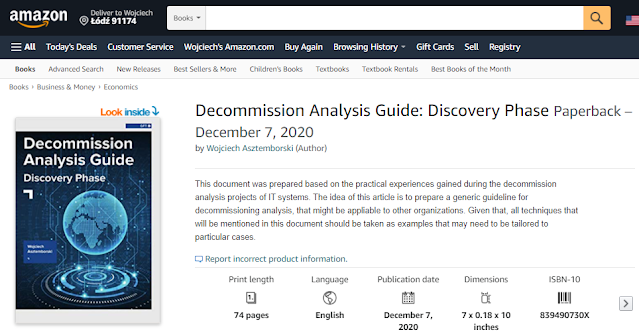Decommission Analysis Guide - book finally released!
Finally is there! My first paper book has been printed out. The "Decommission Analysis Guide" is ready to be picked up from the Amazon bookshelf and read.
If you have been asked to analyze tens (or more) systems in your organization, and you're whole in tears now, this book is for you. That's a practical guide, that will help you to rationalize the task, and embrace a massive number of existing systems you don't know and have no chance to understand.
What is system decommission analysis?
A life cycle of all IT systems ends up with plugging out of the power supply. Before it happens, we need to make sure we understand what is the real scope of the system, and what actually happes once the last led-light goes out.
It's not usually a big deal if we have a single system to analyze and an existing support/developer team already that is up to speed, with an insight into the product. The problem becomes more interesting once you realize you have to analyze tens (or even 100+) of the systems that have been build for the last 20 years. In that case, most of the developers who have built those systems are no longer a part of the organization. Too much faith in existing and reliable documentation may bring you into trouble.
Where can I find a list of the systems?
That's the tricky part - even if it sounds like the easiest. The CMDB repository is always a very good place to start looking. Unfortunately, It may be a huge challenge to find anyone capable to confirm that list, especially if you ask about the systems' boundaries (list of its components).
A very good example might be a database that is shared across two systems - which system owns the database?
Practical guide
The systems' boundary and data flow discovery - that this book is about! This guide will lead you through the whole end-to-end process, starting from the initial workshop, plans and estimates, MVP, the blanket/dedicated analysis, and data aggregation.
During the next couple of weeks, I will try to put more light on the described process, especially in the context of migration (i.e. Cloud Adoption Framework).
Sold for profit - Absoluty NO!
There's no profit for selling this book. The price covers the cost of printing and Amazon's fee only. All of those is to make sure you can get the paper book version without any extra costs.
Special thanks!
This book has been created based on my personal experience working for our clients in GFT, but not only. Given that, I would like thank to GFT Poland, for the support and help.





Comments
Post a Comment